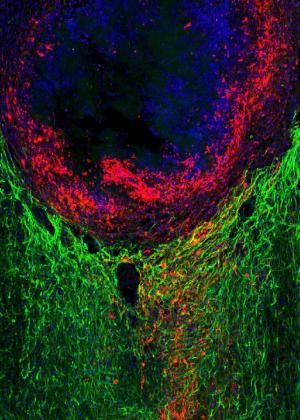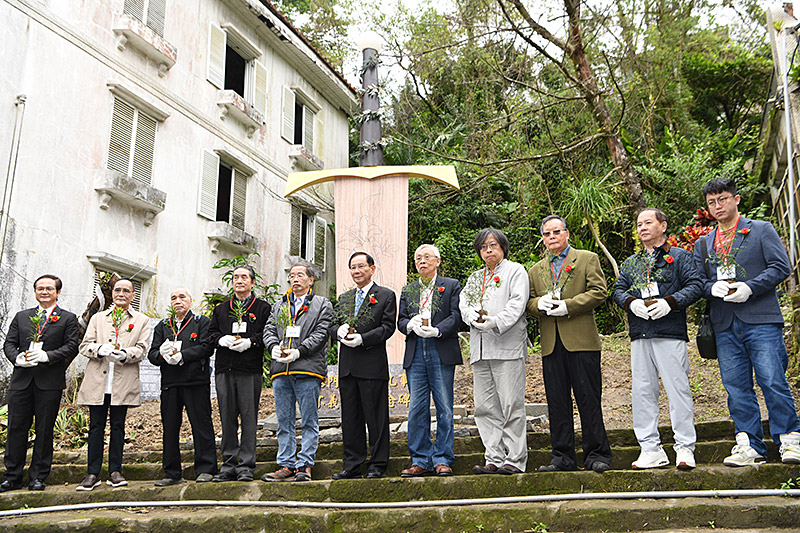New role identified for scars at the site of injured spinal cord
NIH-funded mouse study suggests scar formation may help, not hinder, nerve regrowth.
For decades, it was thought that scar-forming cells called astrocytes were responsible for blocking neuronal regrowth across the level of spinal cord injury, but recent findings challenge this idea. According to a new mouse study, astrocyte scars may actually be required for repair and regrowth following spinal cord injury. The research was funded by the National Institutes of Health.

Benefits of scarring Previously injured axons (in red) can grow through a dense astrocyte scar (in green) in the presence of molecules that stimulate growth (in blue). Decades of research suggested that scars block regrowth after injury.
“At first, we were completely surprised when our early studies revealed that blocking scar formation after injury resulted in worse outcomes. Once we began looking specifically at regrowth, though, we became convinced that scars may actually be beneficial,” said Michael V. Sofroniew, M.D., Ph.D., professor of neurobiology at the University of California, Los Angeles, and senior author of the study. “Our results suggest that scars may be a bridge and not a barrier towards developing better treatments for paralyzing spinal cord injuries.”
Neurons communicate with one another by sending messages down long extensions called axons. When axons in the brain or spinal cord are severed, they do not grow back automatically. For example, damaged axons in the spinal cord can result in paralysis. When an injury occurs, astrocytes become activated and go to the injury site, along with cells from the immune system and form a scar. Scars have immediate benefits by decreasing inflammation at the injury site and preventing spread of tissue damage. However, long-term effects of the scars were thought to interfere with axon regrowth.
Using three different mouse models to examine the effect of astrocyte scars on axonal regrowth, Dr. Sofroniew’s team was able to remove the scars or prevent them from forming after a spinal cord injury. The results revealed that without astrocyte scars, there was no regrowth.
In another experiment of spinal cord injury in mice, Dr. Sofroniew’s team shuttled growth factors, specific molecules that stimulate axons to grow, to the injury site and discovered that there was robust regrowth through astrocyte scars. However, if the researchers prevented scar formation, the regrowth was significantly reduced.
Genetic analyses revealed that astrocytes as well as non-astrocyte cells released a variety of chemicals involved in regrowth at the injury site. In this mix, Dr. Sofroniew and his colleagues found molecules that block regrowth along with molecules that support it.
“This important research provides further evidence about the complexity of the brain and spinal cord’s injury response. It shows that scar forming astrocytes support axon growth and suggests that therapeutics directed only at blocking these cells may not enhance regeneration of the injured spinal cord,” said Lyn Jakeman, Ph.D., program director at the NIH’s National Institute of Neurological Disorders and Stroke (NINDS), which provided funding for the study.
Trauma leads to spinal cord injury in about 12,500 people in the U.S. each year. It is estimated that 276,000 individuals in the country suffer from long-term effects of spinal cord injury. The ultimate goal of spinal cord injury research is to enable connections to develop that cross the level of injury and rewire the normal cord below.
Dr. Sofroniew and his colleagues are planning to investigate the exact mechanisms by which astrocytic scars support growth and ways to increase that response. “These preliminary findings established that axonal growth can occur in the presence of scars in mice. Eventually, we would like to see the regenerating axons grow far enough into healthy tissue to establish functional connections,” said Dr. Sofroniew.
This work was supported by the NIH (NS057624, NS084030, NS060677, MH099559A, MH104069), the Dr. Miriam and Sheldon G. Adelson Medical Foundation and Wings for Life.
The NINDS is the nation’s leading funder of research on the brain and nervous system. The mission of NINDS is to seek fundamental knowledge about the brain and nervous system and to use that knowledge to reduce the burden of neurological disease.
Source: U.S. National Institutes of Health
- 303 reads
Human Rights
Ringing FOWPAL’s Peace Bell for the World:Nobel Peace Prize Laureates’ Visions and Actions

Protecting the World’s Cultural Diversity for a Sustainable Future

The Peace Bell Resonates at the 27th Eurasian Economic Summit

Declaration of World Day of the Power of Hope Endorsed by People in 158 Nations

Puppet Show I International Friendship Day 2020

